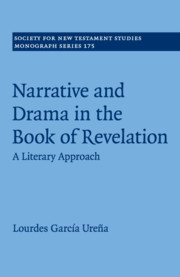Book contents
- Narrative and Drama in the Book of Revelation
- Society for New Testament Studies:
- Narrative and Drama in the Book of Revelation
- Copyright page
- Dedication
- Contents
- Tables
- Preface
- Abbreviations
- Introduction
- 1 The Literary Forms of the Book of Revelation
- 2 John, Eyewitness and Herald of the Visions
- 3 John, Auditory Witness and Herald of the Word
- Epilogue
- Bibliography
- Index of Ancient Sources
- Subject Index
1 - The Literary Forms of the Book of Revelation
Published online by Cambridge University Press: 15 August 2019
- Narrative and Drama in the Book of Revelation
- Society for New Testament Studies:
- Narrative and Drama in the Book of Revelation
- Copyright page
- Dedication
- Contents
- Tables
- Preface
- Abbreviations
- Introduction
- 1 The Literary Forms of the Book of Revelation
- 2 John, Eyewitness and Herald of the Visions
- 3 John, Auditory Witness and Herald of the Word
- Epilogue
- Bibliography
- Index of Ancient Sources
- Subject Index
Summary
In this chapter, it is shown that the textual heterogeneity of the book of Revelation is only on the surface. To the contrary, it has a clear structure, designed to provide unity to the whole: a prologue in which the author provides the guidelines to the reader (1. 1–3); an introductory liturgical dialogue (1. 4–8); an account of the things John saw and heard during his vision (1.9–22.16); and a closing liturgical dialogue (22.17–21). After this, the type of account constituted by Rev 1.9–2.16 is examined, through analysis of previous proposals. We conclude that Rev 1.9–2.16 is a special narrative, with the following characteristics: the use of a homodiegetic narrator (allowing John to simultaneously appear as a witness to the story and as one of its characters, and thus to highlight the veracity of the story he tells); a flexibility in the use of space–time coordinates; the variety of characters that participate in the plot; the fact that the plot has a happy ending; etc. Finally, I explore the author’s purpose of showcasing the truthfulness of the narrative.
Keywords
- Type
- Chapter
- Information
- Narrative and Drama in the Book of RevelationA Literary Approach, pp. 6 - 65Publisher: Cambridge University PressPrint publication year: 2019



